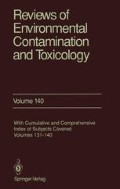Abstract
The history of agricultural harvesters being clinically poisoned from working in a field following a “recent” organophosphate (OP) insecticide application dates back to their earliest use circa 1950. Initially, the documentation was sporadic case reports (Abrams and Leonard 1950; Ingram 1951; Quinby and Lemmon 1958; Milby et al. 1964). Summaries began to be published beginning in 1974 (Milby et al. 1974; Spear et al. 1975; NIOSH 1976; Gunther et al. 1977; Popendorf and Leffingwell 1982; and Honeycutt et al. 1985).
Access this chapter
Tax calculation will be finalised at checkout
Purchases are for personal use only
Preview
Unable to display preview. Download preview PDF.
References
Abrams HK, Leonard AR (1950) Toxicology of organic phosphate insecticides. Calif Med 73: 183 – 186.
ACGIH (1991) Threshold limit values and biological exposure indices for 1991–92. Am Conf Governmental Ind Hyg, Cincinnati, OH, pp 48 – 51.
Ames RG, Mengle DC (1991) Analyzing cholinesterase measurements: Assumptions, statistics, and interpretations. J Occup Med 33 (2): 101 – 112.
California Administrative Code (1979) Title 3 (agriculture), article 23 (pesticide worker safety), parts 2479, field worker safety. Sacramento, CA (revised Jan 1979 ).
(CDFA) (1981) California crop and livestock reporting service. Sacramento, CA. CDFA (1972–84). Pesticide use reports, Sacramento, CA.
EPA (1974) Reinstatement of certain existing standards. Fed Reg 39: 16888, May 10, Washington DC.
Gage JG (1967) The significance of blood cholinesterase activity measurements. Residue Reviews 18: 159 – 173.
Gaines TB (1969) Acute toxicity of pesticides. Toxicol Appl Pharmacol 14:515– 534.
Gehrich JL, Burkart JA, Takade DY, Turner ER, Allen SD (1976) Final Report: Assessment of leaf surface residues for selected organophosphorus insecticides. Univ Utah Res Inst, Salt Lake City, UT.
Grob D, Harvey AM (1958) Effects in man of the anti-cholinesterase compound sarin (isopropyl methyl phosphonofluoridate). J Clin Inv 37: 350 – 368.
Gunther FA, Iwata Y, Carman GE, Smith CA (1977) The citrus reentry problem: Research on its causes and effects, and approaches to its minimization. Residue Reviews 67: 1 – 139.
Honeycutt RC, Zweig G, Ragsdale NC (eds) (1985) Dermal exposure related to pesticide use: Discussion of risk assessment. ACS, Washington DC.
Ingram FR (1951) Health hazards associated with use of airplanes for dusting crops with parathion. Am Ind Hyg Assoc Quart 12: 165 – 170.
Iwata Y (1980) Minimizing occupational exposure to pesticides: Reentry field data— a recapitulation. Residue Reviews 75: 127 – 147.
Leffingwell JT, Spear RC, Jenkins D (1975) The persistence of ethion and zolone residues on grape foliage in the Central Valley of California. Arch Environ Contam Toxicol 3: 49 – 53.
Lentner C (1984) Geigy scientific tables, Vol 3, 8th ed. Ciba-Geigy, West Caldwell, NJ.
Milby TH, Ottoboni F, Mitchell H (1964) Parathion residue poisoning among orchard workers. J Am Med Assoc 189: 351 – 356.
Milby TH, Bailey JB, Davies JE, Guthrie FE, Hays HW, Long KR, May J, Wymer WH (1974) Occupational exposure to pesticides. 0-551-026, Rept of Fed Working Group on Pest Management, US Govt Printing Office, Washington, DC.
Morgan DP (1989) Recognition and management of pesticide poisonings, 4th ed. 0-222-597, US Govt Print Off, Washington, DC.
NIOSH (1976) Proceedings of symposium on pesticide residue hazards to farm workers. US Dept HEW Publ 76–191, Washington, DC.
Odeh RE, Evans JO (1974) The percentage points for the normal distribution, AS 70. Appl Statist 23: 96 – 97.
OSHA (1989) Health standards (29 CFR 1910.1000), US Dept Labor Publ. 2206, Washington, DC.
Owens EW, Owens SY (1984) Biophosphate and some health effects. Science 000.
Peoples SA, Maddy KT (1978) Organophosphate pesticide poisoning. West J Med 129: 273 – 277.
Popendorf W, Spear RC (1974) Preliminary survey of factors affecting the exposure of harvesters to pesticide residues. Am Ind Hyg Assoc J 36: 374 – 380.
Popendorf W, Leffingwell JT (1978) Natural variations in the decay and oxidation of parathion foliar residues. J Agric Food Chem 26: 437 – 441.
Popendorf W, Leffingwell JT (1982) Regulating OP pesticide residues for farmworker protection. Residue Reviews 82, 125 – 201.
Popendorf WP (1985) Advances in the unified field model for reentry hazards. In: Honeycutt RC, Zweig G, Ragsdale NC (eds) Dermal exposure related to pesticide use: Discussion of risk assessment. ACS, Washington, DC, pp 323 – 341.
Popendorf W (1990) Effects of organophosphate insecticide residue variability on reentry intervals. Am J Ind Med 18: 313 – 319.
Quinby GE, Lemmon AB (1958) Parathion residues as a cause of poisoning in crop workers. J Am Med Assoc 166: 740 – 746.
Ray R (1972) Occupational exposure to organophosphate pesticides among agricultural workers and their families. MS thesis, Univ. Calif, Berkeley, CA.
Rubinstein RY (1981) Simulation and the Monte Carlo method. Wiley, New York.
Spear RC, Milby TH, Jenkins DI (1975) Pesticide residues and fieldworkers. Environ Sci Technol 9: 308 – 313.
Spear RC, Popendorf WJ, Leffingwell JT, Milby TH (1977) Worker poisoning due to paraoxon residue. J Occup Med 19: 411 – 414.
Turrell FM (1961) Growth in the photosynthesis area of citrus. Bot Gaz 122: 284 – 298.
Wichmann BA, Hill ID (1982) An efficient and portable pseudo-random number Generator, AS 183. Appl Stat 31: 188 – 190.
Wills JH, Dubois KP (1972) The measurement and significance of changes in the cholinesterase activities of erythrocytes and plasma in man and animals. CRC Crit Rev in Toxicol 1: 153 – 202.
Winterlin W, Kilgore W, Mourer C, Mull R, Walker G, Knaak J, Maddy K (1978) Dislodgeable residues of Dialifor and Phosalone and their oxygen analogs following a reported worker-injury incident. Bull Environ Contam Toxicol 20:255– 260.
Author information
Authors and Affiliations
Editor information
Editors and Affiliations
Rights and permissions
Copyright information
© 1992 Springer-Verlag New York, Inc.
About this chapter
Cite this chapter
Popendorf, W. (1992). Reentry Field Data and Conclusions. In: Ware, G.W. (eds) Reviews of Environmental Contamination and Toxicology. Reviews of Environmental Contamination and Toxicology, vol 154. Springer, New York, NY. https://doi.org/10.1007/978-1-4612-2208-8_5
Download citation
DOI: https://doi.org/10.1007/978-1-4612-2208-8_5
Publisher Name: Springer, New York, NY
Print ISBN: 978-1-4612-7459-9
Online ISBN: 978-1-4612-2208-8
eBook Packages: Springer Book Archive

